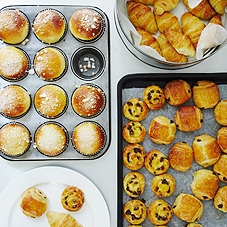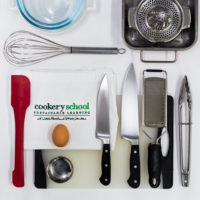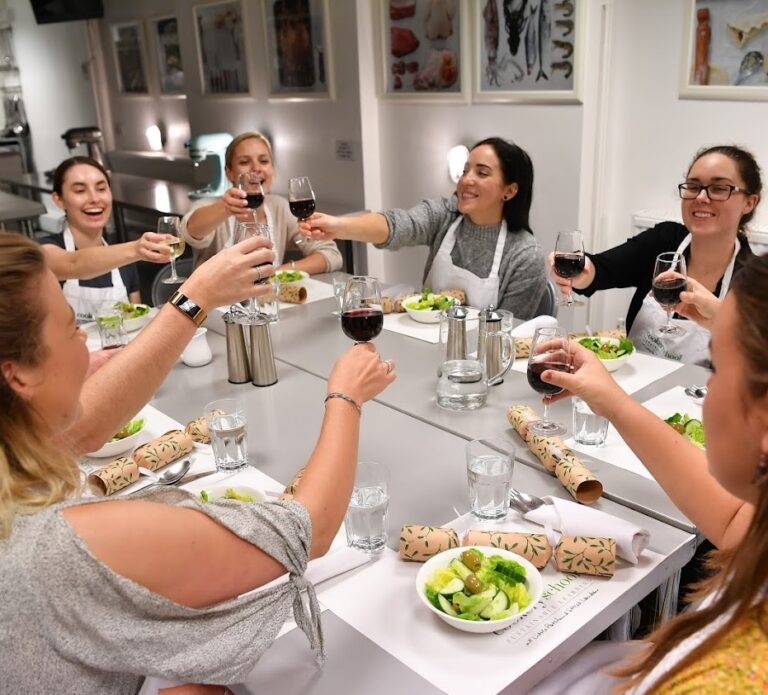RECIPE: Rice Basics – boiled, Persian and risotto

At Cookery School we teach to empower so that everyone has the confidence to replicate recipes again and again at home. We also teach by principle – if you can understand how to make one soup, you can make a whole range of different soups using the same principle.
During our time at home, in isolation, these principles have never been more pertinent, when we all need to cook a lot more. We will be sharing simple, home-cooked weekly recipes with you, so that your experience of cooking during Covid-19 is a positive one, with new recipes learnt and delicious dishes enjoyed.
Rice – boiled, Persian and risotto
Boiled: basic principles
• Use the evaporation method, where rice is cooked in an exact amount of water which is absorbed by the rice, leaving no water at the end
• Bring to the boil and then turn the temperature down
• You will produce light and fluffy rice
Perfect boiled rice
Feeds 8
Ingredients
450g / 1lb round-grained rice (for speciality rice and basmati follow packet cooking instructions as they generally require less water
1.5L / 2 ½ pints cold water (usually double the amount of rice to water)
Method
- 1. Place the rice in a thick-bottomed saucepan. Add the water and bring to the boil.
- 2. Reduce the heat so that the rice bubbles gently. Do not cover with a lid and do NOT stir.
- 3. When the surface of the rice is pitted and all the water has evaporated, the rice should be cooked. This typically takes about 30-35 minutes for wholegrain brown rice.
- 4. If you taste the rice and the centre is hard add 150ml of boiling water to the pan and allow to cook and evaporate. Taste again. A slight hissing sound can be heard and indicates that all the water has evaporated.
- 5. Lightly fluff up the rice with a fork and serve.
Persian rice
Feeds 8
Ingredients
4 tablespoons of olive oil
1 onion, peeled and chopped
6 cardamom pods
6 cloves
1 teaspoon ground cinnamon
1 cinnamon stick
½ teaspoon saffron
4 tablespoons sultanas
1.5L / 2 ½ pints chicken or vegetable stock
4 tablespoons pine nuts
Method
- 1. Pour the oil into a saucepan over a medium heat, add the onion and fry until golden brown.
- 2. Add the rice to the saucepan and coat well with the oil.
- 3. Add the cardamom, cloves, cinnamon powder and stick, saffron and sultanas.
- 4. Add the stock and bring to the boil.
- 5. Reduce the heat and allow to simmer uncovered for about 20 minutes or until the water has evaporated and the rice is tender.
- 6. Gently fluff up the rice with a fork.
- 7. Brown the pine nuts in a dry frying pan and sprinkle on top of the rice before serving.
Risotto: basic principles
• Risotto follows the same principles as other rice recipes in that the liquid is used to cook the rice and is absorbed by the end of the cooking process
• Risotto always cooks in stock, and wine if desired, but not water
• Unlike boiled rice risotto is stirred continuously during cooking, which releases the starch in the rice grains, resulting in a creamy dish
Basic risotto
Feeds 4-6
Ingredients
4 tablespoons olive oil
1 large onion, peeled and finely chopped
285g / 10oz risotto rice (Arborio)
1 wine glass of white wine
1.2L / 2 pints hot vegetable or chicken stock (a little more may be required)
85g / 3oz Parmesan cheese, grated
Method
- 1. Pour the oil into a saucepan over a medium high heat, add the onion and fry until light golden brown.
- 2. Add the rice to the saucepan and coat well with the oil.
- 3. Pour in the white wine and cook quickly until evaporated.
- 4. Keep the stock over a medium high heat, add a ladleful at a time to the rice, stirring continuously. Continue to add stock until it has all been absorbed. This should take about 25 minutes.
- 5. The rice should have a little ‘bite’ to it when cooked. When done, remove from the heat and stir in the Parmesan.
- 6. Risotto should be eaten immediately before it congeals and becomes sticky. If you need to ‘hold’ it before serving, cook for about 15 minutes and then finish off by adding the final amount of stock just before eating.
Variations
Pesto risotto
Add 5 tablespoons of pesto to the risotto just before serving.
Asparagus risotto
Large bunch of asparagus
-
- 1. Prepare the asparagus by removing the inedible ‘woody’ pieces at the bottom of the spears. Do this by snapping the asparagus just above the woody parts. Keep both parts.
- 2. Chop the asparagus spears into + 2cm pieces.
- 3. Cover with water and bring to the boil. Cook until asparagus are just tender but not soft.
- 4. Lift the asparagus pieces out but retain the cooking water. Set aside the asparagus pieces.
- 5. In the liquid in which the asparagus were cooked, place the woody ends and cook until soft, to extract maximum flavour. Strain off woody pieces, discard but keep the liquor.
- 6. Measure this asparagus liquor. You require 1.2L of ‘stock’ in total so if insufficient, add a little boiling water to it to make up to required amount. Add dried vegetable bouillon to it as per instructions on packet or add chicken stock.
- 7. After 15 minutes of cooking the risotto, add the par-cooked asparagus pieces, continuing to add the stock until all used up.
Wild mushroom risotto
Fry 1 chopped garlic clove in 2 tablespoons of olive oil and then add 285g / 10oz sliced wild mushrooms and fry for a few minutes, until the liquid has gone. Add the cooked mushrooms to the risotto halfway through the risotto cooking process.
Barley risotto
If you don’t have any risotto rice then barley is an excellent substitute as it has similar characteristics as Arborio rice.
-
- 1. Use 300g barley with 1.2L / 2 pints of stock
- 2. When you come to add all the stock, add it all at the same time and bring to boil. Then turn down and cook for about twenty minutes or until the barley is starting to soften. Stir from time to time to ensure that barley does not stick to saucepan. As the liquid finishes evaporating keep stirring – the barley is more likely to stick to the saucepan as the stock evaporates.
Nutritious – as well as a good source of plant-based protein, barley grains are full of a range of nutrients, including, magnesium which works to turn our food into energy and keep muscles and nerves working, iron and vitamin B6 which keep our blood healthy, and selenium, which helps to keep the immune system working well.
Cooking during Covid-19
We have a wealth of experience to share in these unprecedented times if you need help cooking during Coronavirus. We’ll be giving you tips and recipes on using store cupboard ingredients, preserving, pickling & above all making the most of your valuable ingredients & not wasting food. PLEASE let us have YOUR questions and SHARE on Facebook or Instagram what you’ve been cooking & our founder Rosalind will be able to get back to you with answers so we can all learn from each other.




